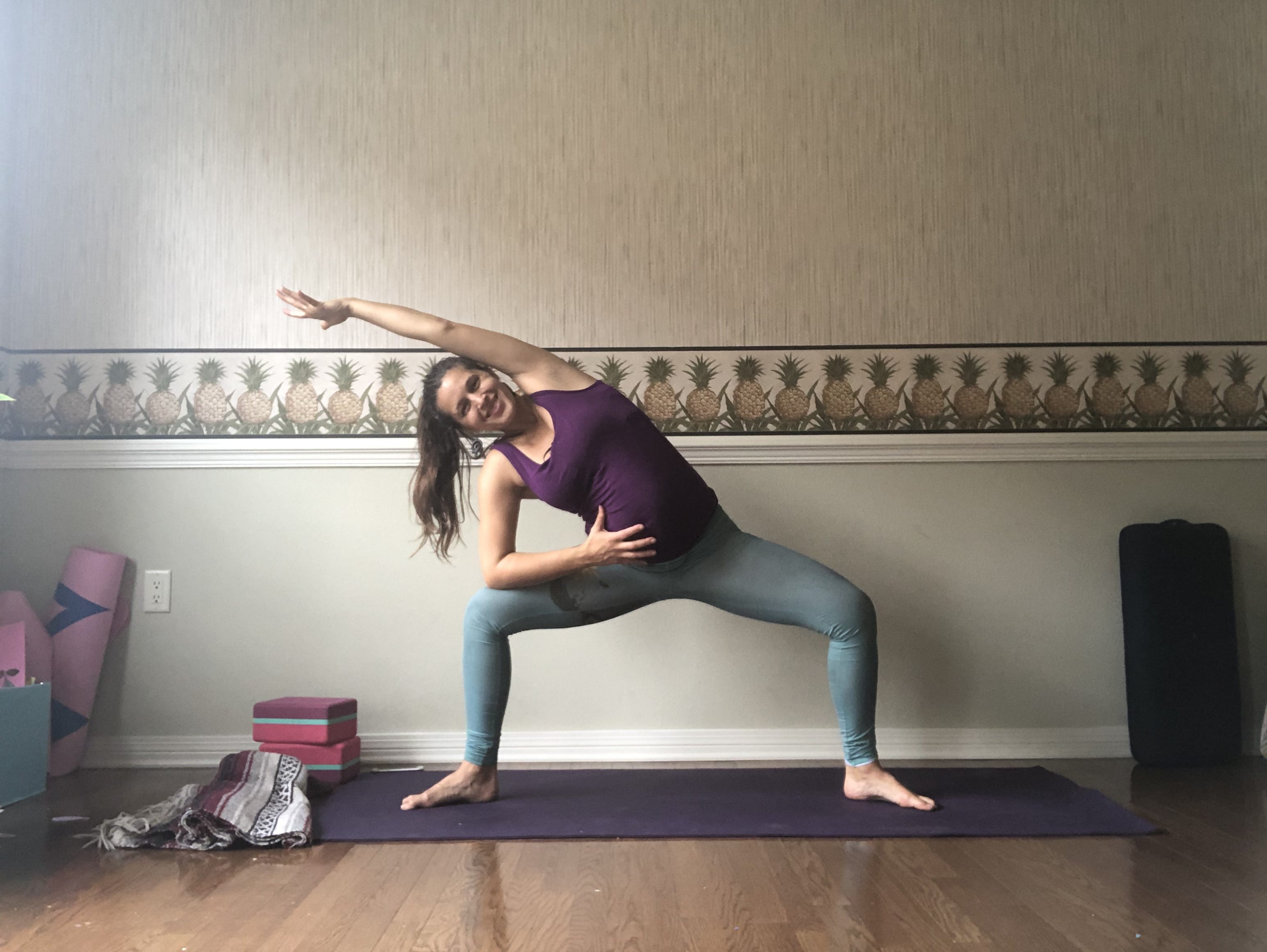I think it’s time to tell the truth about prenatal yoga.
For far too long, prenatal yoga has been taught as a series of precautions and contraindications. Every yoga pose is seen as a way for mom and baby to get seriously injured on the yoga mat. All that’s left for pregnant moms are a few standing poses and seated poses.
Why are pregnant women taught to be afraid of their bodies and their yoga practice during pregnancy?
Fear-mongering has no place in yoga.
It only serves as a way to disempower women during a fairly emotional and important time of their lives.
I’m going to debunk a bunch of prenatal yoga myths so we can finally see the truth about prenatal yoga.
Myth # 1:
No Twisting During Pregnancy
This is probably the one that comes up the most and there are a few things to unpack. First, the idea that you can’t twist during pregnancy has no scientific basis in fact. Twisting your body during pregnancy is not going to do any significant damage to you or your baby during pregnancy. You’d have to twist very violently and dramatically in order to create any injury to yourself or your baby. Not highly likely in yoga.
Second, it’s more about physical reality than danger. The bigger your belly becomes during pregnancy, the harder it is to twist.
A pregnant belly is built like a fortress. It’s not squishy; that sucker is rock solid. And the more pregnant you get, the more immobile it becomes. So twisting becomes less and less possible. At least deeper twists, like taking your elbow to the outside of your knee.
You can still do more open twists, though.
A twist from a lunge, for example, with one hand down and the other arm reaching up, feels really lovely. And if you need more space, you can move your front leg over more so your belly has room.
Lesson learned: Twisting is A-OK during pregnancy.
Myth #2:
Avoid Core Work During Pregnancy
This one isn’t fear-based so much as it’s thought that core work during pregnancy is excessive.
And I get it. I mean, your abs are already doing a lot of work during pregnancy, as they stretch to capacity and try really hard to hold everything together.
This doesn’t mean you can’t still engage those muscles or that it would be detrimental to the health of your body or baby during pregnancy.
Truthfully, accessing your core muscles during pregnancy can be really useful, especially during your first and second trimester.
Using your core muscles will help you with your balance and pelvic floor tone. Plus, using your core muscles during your 1st and 2nd trimesters will also just help those muscles stay active, engaged, and strong. — and easier to rebuild and reconnect to postpartum.
I also want to be clear that I’m not talking about doing crunches or deep abdominal work. I’m talking about using your core muscles to create stability, tone, and connection.
You’re not working on building a 6-pack during your pregnancy.
And by the time you get to your 3rd trimester, having super-defined abs will be the furthest thing from your reality or from what feels good. So your core work will be way more mellow.
Maybe even non-existent as you focus more on grounding, side body length, and making more space in your torso.
Lesson learned: Core work can actually be beneficial during pregnancy!
Myth #3:
You Can’t Lay on Your Belly During Pregnancy
This isn’t entirely inaccurate. It’s just that it’s only part of the picture — the part of the picture that takes place around 18-20 weeks pregnant.
Listen, it should be fairly obvious that when your belly gets bigger, you can’t put your entire body weight on it. This means poses like Dhanurasana (bow pose) or Salabasana (locust pose) or Mayurasana (peacock pose) are off the table.
That said, you can still do Cobra Pose, in which your belly is resting more on the floor. The difference is that you can use your arms to help hold you up and keep the weight off of your belly.
This is another one of those “pregnancy rules” that doesn’t apply universally to every stage of pregnancy. That’s one of the big problems with all of the physical restrictions put on women during pregnancy. These restrictions are given as blanket statements for the entire pregnancy when in fact, you can still do lots of things during your first trimester and into your second trimester that are listed as “pregnancy contraindications.”
Lesson learned: Most pregnancy contraindications are intended for later stages of pregnancy. Until it’s uncomfortable, being belly down is totally fine.
Myth #4:
No Inversions During Pregnancy
This is one relative to a woman’s yoga experience prior to pregnancy, as well as how she feels in her body during her pregnancy.
Going upside down won’t harm the woman or the baby.
It also won’t turn the baby from being head down any more than the baby will turn itself. I have seen this as a reason to avoid inversions during pregnancy on several blogs and it’s complete and total, non-scientific bunk.
Here’s the deal: there are certain conditions that would take inversions out of a woman’s practice. Pre-eclampsia, high blood pressure, super low blood pressure, thin placenta, short cervix, or other high risk pregnancy issues.
If a woman is healthy and strong and has practiced inversions before and they still feel good, there is no reason to not practice them.
I can personally say that in 3 pregnancies, inversions felt different for me in all 3.
And towards the end of each pregnancy, I was more interested in getting my energy and baby to move downward instead of upward. So I elected to stop them when I felt my body was ready to prep for labor and delivery.
Lesson learned: Inversions are not for everyone during pregnancy, but it also doesn’t make them unsafe.
Myth #5
Kegels Are The Key to a Healthy Pregnancy
One of the keys to a healthy pregnancy is good pelvic floor tone. It’s just that kegels won’t actually do that for you.
Listen, if you want to do kegels, that’s your business. But you’re better off doing squats.
You want your pelvic floor to be able to expand and contract.
Kegels only teach you the contraction part.
If you have a vaginal delivery, you want to be able to push the baby out. If your pelvic floor muscles are too tight and too rigid (thanks, kegels), that becomes harder.
Don’t believe me. Believe Dr. Katy Bowman. She writes all about it here.
The big issue with kegels, as Katy Bowman points out is that they are overused and often improperly done.
Squats, on the other hand, are hard to screw up. They’re fantastic for a more functional pelvic floor, not to mention awesome prep for labor, great for your legs, glutes, and low back.
Lesson learned: Squats are way better for pelvic floor health than kegels.
Myth #6:
You Can’t Lie on Your Back When You’re Pregnant
This one is another case of a blanket instruction for all of pregnancy vs when it’s actually useful.
Here’s the situation: As the cluster of cells forming into your eventual baby grows larger, it will start putting more pressure on your spine (among other things), when you’re lying on your back. So as your pregnancy progresses, lying on your back won’t be as comfortable.
Good news: You’ll know pretty quickly if something isn’t right. Your back will feel funny or flat out hurt. Or you might feel nauseous. Otherwise, nothing terrible will happen.
Also, some women can lie on their backs with comfort throughout their pregnancy for shorter periods of time. Savasana is a short period of time.
I’m not saying do it just because. There are loads of other savasana options. You can find one here on my YouTube channel.
All I’m saying is that it’s not going to do serious damage.
Lesson learned: Lying on your back only becomes an issue the further into pregnancy you are.
So now you know the truth about prenatal yoga. Or at the very least, some myths have been cleared up so that you’re not scared of practicing yoga while pregnant.
Here are a few important takeaways:
♥ Pregnancy isn’t the time to start doing things you didn’t do pre-pregnancy.
This means if you didn’t have a yoga practice filled with inversions and arm balances and backbends, you don’t need to add them all in now. You can stick with the yoga practice that is more familiar to you, whatever that looks and feels like.
♥ You can also CHOOSE to scale back, even if you had a more “advanced practice” pre-pregnancy. There are plenty of reasons to take it easy during pregnancy. Whether those reasons are because your pregnancy is higher risk or you prefer to err on the side of caution or it just feels better to play it mellow, how you practice yoga during your pregnancy is YOUR CHOICE.
♥ Most pregnancy contraindications are intended for later in pregnancy but are often used as blanket generalizations for all of pregnancy.
♥ Listen to your body. Adjust as needed. Just because a pose feels good one day doesn’t mean it will feel awesome the next day. And vice versa.
♥ Don’t let pregnancy fear-mongering that is not science or evidence based make you fear your own body. Trust your body. Listen to your body (yes, I’m repeating what I wrote above. It’s important). And respect the wishes of your body, whatever they are.
And if you need some extra support during your pregnancy or don’t know where to start, here’s my FREE yoga practice series for pregnancy, Prenatal Yoga Favorites.
You get 9 yoga practices that will support you and your body from the moment you decide to roll out your mat until baby is ready to make her entrance! Suitable for all trimesters, all bodies, and all levels of yogi.
Click here to get access to these classes!



